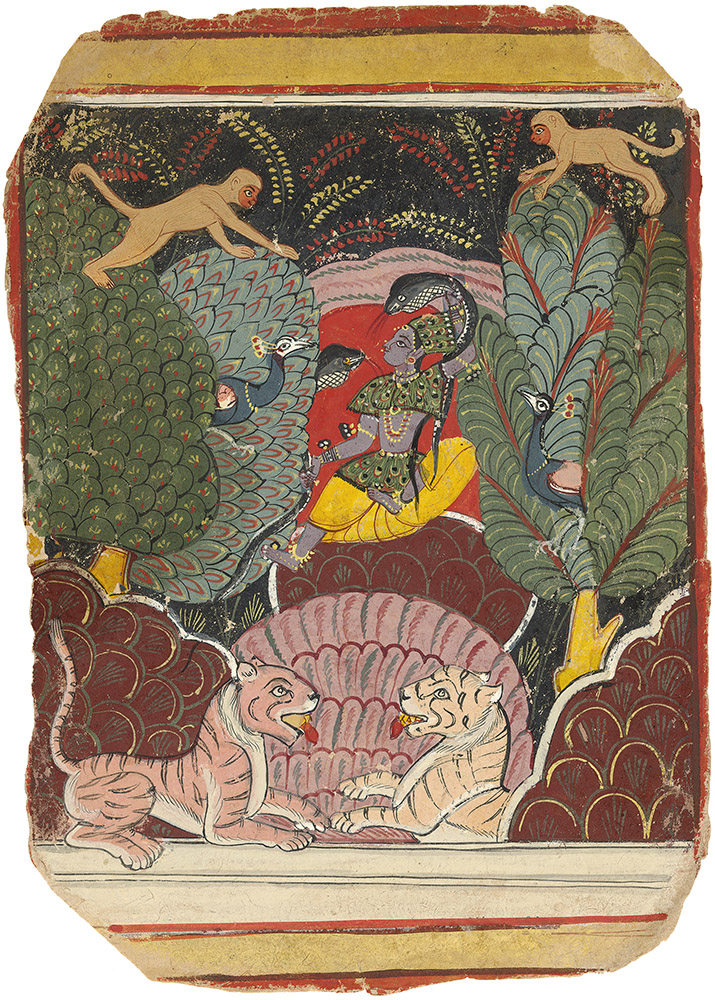
This extraordinary 17th century illustration of Asavari Ragini, formerly in the collection of the renowned polymath, Paul F. Walter, is a delicate and expressive work where, through chromatic variation and dynamic animation, the artist achieves projects a remarkable range of emotion and harmony, much as the musical modes it aims to represent. By contrasting lush against muted colours, the scene is played out as a dramatic encounter with constantly changing tonalities and variations, in many ways akin to a musical composition. The dramatic undertones are punctuated through the animation of the animals and vegetation as they play their roles as friend or foe, discord or melody.
The Asavari Ragini is a representation of musical modes that are divided into male (ragas) and female (ragini) emotions. The emotions are variations on either the union or separation of lovers. In this painting, Asavari, a Hindustani classical raga that is performed in the morning hours, is represented by a female heroine, nayika, a woman belonging to the Savaras tribe of snake charmers who seduces snakes either through her dance or through her music and brings them down from sandalwood trees. The cool blue colour of her skin indicates her status as someone who lives on the fringes of society. It also signifies that she possesses unusual powers, including the ability to tame snakes. As folk music is thought to be the source from which the many streams of classical music originated, Asavari is, therefore, depicted with tribal characters in forest settings alluding to its ancient folk roots.
The blue skinned Asavari herself has been depicted against a red ground implying her divinity; in this context, the blue colour of her skin indicates her status as someone who lives on the fringes of society. It also signifies that she possesses unusual powers, including the ability to tame snakes. This is a serious Raga, one of contemplation, serenity and deep spirituality.
The artist has used a remarkable chromatic range to capture the translucent glow of Asavari as she sits within the dense vegetation of the forest. By layering chromatic passages – from red through green and to black – the protective atmosphere of an environment which she is deftly skilled to dialogue with. The artist has also employed the animation of animal characters to illustrate the primeval environment of this raga: in the foreground two docile-looking tigers face each other and project an amiable character while two peacocks, their feathers in full display, flank Asavari as she dominates the snakes. Setting the dramatic stage even further are two monkeys, who acrobatically jump from tree to tree above her.
The artist also alludes to both the ŕishabhs, the second svara (musical note and tone), which are here represented as hooded cobras drawn out from the perfumed sandalwood trees to embellish the mood of the Raga. The range is held in counterbalance by Asavari, who strikes a stance of a classical dancer - one arm aloft, the other lowered in an expository pose. It is impossible to say which of the ŕishabhs, the higher or the lower, held prominence during the performance as depicted by artist, but quite clearly the artist has sought to bring out this specific nuance of the Raga that would have appealed or reminded his patron of a particular performance.
Verso inscribed in Devanagari: Asavari Malkos ki. 28; Ragini Asavari of Malkauns, page no. 28
Provenance: Paul. F. Walter Collection, New York, acquired in 1984.
Price On Request
|

